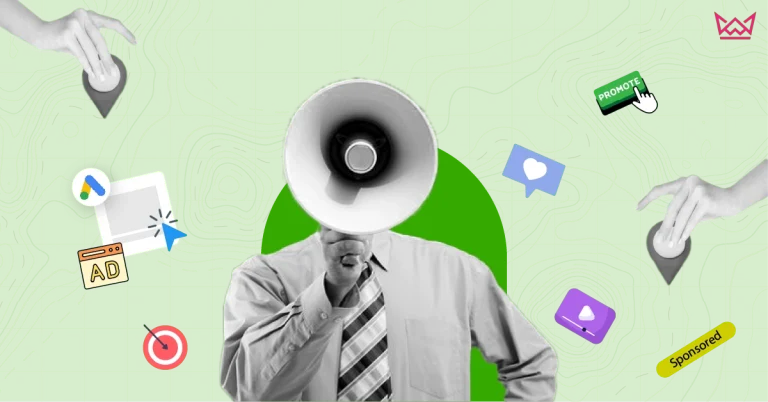Digital marketing has reshaped how businesses connect with their audiences. It’s not just about having a website or posting on social media—it’s about creating intentional, goal-driven campaigns that bring in results. This is where a digital marketing strategy steps in. It provides structure to your efforts, ensures your message reaches the right people, and helps you stay focused on measurable outcomes.
But here’s the catch: not every brand that goes online gets noticed. The difference lies in how well you plan, adapt, and execute. A clear strategy tells you what to do, which platforms to use, what content to create, and how to track success. Whether you’re just starting or looking to fine-tune your current plan, understanding proven digital marketing techniques and tactics can give your brand a real edge.
In this blog, we’ll break down the essentials—what a digital marketing strategy is, how to build one step-by-step, smart tactics that drive engagement, and examples of what works out there.
What is a Digital Marketing Strategy?
A digital marketing strategy is your game plan for reaching people online and turning them into loyal customers. It’s a blueprint that outlines your business goals, identifies the right audience, selects the best online channels, and maps out the actions needed to grow your brand digitally.
Many confuse digital marketing strategy with digital marketing tactics, but here’s the difference: the strategy is the overall plan, while tactics are the specific actions you take, like running Google Ads or sending a newsletter. Strategy guides your direction; tactics handle the execution.
A good strategy doesn’t just focus on visibility. It aligns every digital effort—ads, content, social media, SEO—towards one purpose: helping your business grow. And to do that, you need a structure or a digital marketing strategy framework that keeps everything aligned and measurable.
Whether you’re launching a product, building a brand, or entering a new market, your strategy decides how effectively you get noticed, how you engage users, and how you convert them into customers.
Core Elements Of A Digital Marketing Strategy
A solid digital marketing strategy isn’t built overnight. It takes a thoughtful mix of planning, tools, and consistent execution. These are the key elements that form the foundation of any effective strategy:
- Clear goals and KPIs: Set specific business objectives—like increasing website traffic, generating leads, or improving conversions—and define how you’ll measure them.
- Audience understanding: Know who you’re targeting. Segment your audience based on age, location, behavior, needs, or buying stage to personalize your approach.
- Channel selection: Pick the right mix of platforms—search engines, email, social media, paid ads—based on where your audience spends time and what fits your goals.
- Content planning: Build a content roadmap that supports your goals, from blog posts and videos to social media updates and landing pages.
- Budget allocation: Distribute your budget across platforms and campaigns wisely. Focus more on what gives you the best ROI rather than spreading too thin.
- Performance tracking: Use tools like Google Analytics, HubSpot, or SEMrush to keep an eye on your metrics and tweak your campaigns based on data.
Every element needs to work together. When they do, your digital marketing strategy becomes more than just a plan—it becomes a growth engine.
Digital Marketing Techniques That Work
Planning is one side of the coin. Execution is the other—and that’s where techniques come into play. The right digital marketing techniques help you bring your strategy to life and achieve real results. Below are some of the most effective ones used by marketers across industries:
1. Search Engine Optimization (SEO)
SEO helps your brand become discoverable on search engines like Google. It covers:
- On-page SEO: Optimizing your website content, headings, images, and keywords.
- Off-page SEO: Building high-quality backlinks and domain authority.
- Technical SEO: Improving site speed, mobile responsiveness, and indexing.
When done consistently, SEO drives free traffic, builds trust, and supports long-term growth. It’s slow to start but has one of the best returns over time.
2. Pay-Per-Click Advertising (PPC)
If you want instant visibility, PPC is your go-to. You pay only when someone clicks on your ad. PPC can be run across:
- Search engines (Google Ads, Bing Ads): Target users based on their search intent.
- Social media (Facebook, LinkedIn, Instagram): Use audience-based targeting for reach and awareness.
- Display networks: Show visual ads on relevant websites or apps.
PPC is powerful for generating leads fast, promoting time-sensitive offers, or targeting specific segments with precision.
3. Content Marketing
Content is still king. It’s how you educate, inform, and win your audience’s trust. A content strategy may include:
- Blog posts to boost SEO
- Videos for visual storytelling
- Whitepapers and guides for B2B lead generation
- Infographics and case studies to showcase value
Content doesn’t sell directly—it builds credibility, nurtures trust, and leads your audience down the funnel over time.
4. Email Marketing
Email marketing is one of the highest-ROI channels. With a well-segmented list and compelling content, you can:
- Welcome new subscribers
- Share product updates and offers
- Send abandoned cart reminders
- Re-engage cold leads
What makes email powerful is its directness—it lands right in someone’s inbox and allows for highly personalized communication.
5. Social Media Marketing
Social platforms are where attention lives. The goal is not just to post, but to create engagement. Each platform has its strengths:
- Instagram & TikTok: Great for visuals and storytelling
- LinkedIn: Ideal for B2B and professional networking
- Facebook: Effective for community building and ads
- X (Twitter): Useful for short updates and trending conversations
The key is to stay consistent, track what works, and evolve with your audience’s behavior.
6. Influencer Marketing
People trust people more than brands. Influencers bridge that gap. You can collaborate with:
- Micro-influencers (1k–100k followers) for niche, loyal audiences
- Macro-influencers (100k–1M+) for broader reach
- Industry experts for thought leadership
Their endorsements can spark curiosity, drive conversions, and grow awareness—if the fit is authentic.
7. Affiliate Marketing
Want to grow without hiring a big sales team? Let others sell for you. With affiliate marketing, you offer a commission to partners for every sale or lead they bring in. It’s:
- Cost-effective
- Scalable
- Easy to track and manage via affiliate software
Best suited for eCommerce, SaaS, and online service providers.
8. Remarketing Techniques
Not every visitor converts on the first visit. Remarketing helps you follow up. You can:
- Show ads to people who visited your site but didn’t act
- Remind them of what they left behind in their cart
- Offer limited-time discounts or new benefits to return
It keeps your brand top-of-mind and increases your chances of conversion with warm leads.
All these techniques don’t work in isolation. The best results come when you combine them, based on your digital marketing strategy. Use content to build interest, SEO to attract traffic, PPC for immediate reach, and email or remarketing to close the loop.
Top Digital Marketing Strategies (With Examples)
Techniques are your tools, but strategies decide how you use them. A digital marketing strategy brings everything together—your goals, audience, content, and channels. Below are some of the most effective digital marketing strategies businesses use today, along with examples to show how they work in action.
1. Omnichannel Marketing Strategy
This strategy focuses on providing a consistent experience across all channels—website, email, social media, and ads. The idea is to meet the customer wherever they are, with the same tone, branding, and messaging.
Example: A fashion brand that runs Facebook ads, sends promotional emails, shows product retargeting on Google, and has a seamless mobile app—all synced to a user’s activity.
2. Data-Driven Marketing Strategy
Instead of guessing what works, this strategy relies on analytics. Marketers track user behavior, click-through rates, conversion data, and campaign performance to make informed decisions.
Example: An e-commerce store analyzes abandoned cart data and sends personalized emails with discounts to recover those sales.
3. Personalization And Automation
Personalized content increases engagement. Add automation, and you can scale that personalization without doing it manually every time. This strategy is about using tools to send the right message to the right person at the right time.
Example: A SaaS company uses marketing automation tools to send different onboarding emails based on how far a user has explored the product.
4. Mobile-First Marketing Strategy
With mobile users outnumbering desktop users, a mobile-first approach focuses on fast-loading pages, mobile-friendly emails, and vertical video content that’s optimized for phones.
Example: A food delivery app that runs short Instagram reels, sends app push notifications, and offers one-click ordering via mobile—all designed for users on the go.
5. Content-Led Strategy For Thought Leadership
Instead of pushing sales, this strategy focuses on educating, informing, or inspiring. It helps brands build trust, especially in B2B or high-investment purchases.
Example: A cybersecurity company publishes detailed blogs, runs webinars, and shares case studies to position itself as a trusted advisor rather than just a service provider.
6. Social Proof And User-Generated Content Strategy
Customers trust other customers. A strategy built around reviews, testimonials, and user-generated content can drive conversions faster than branded messages.
Example: A skincare brand reposts customer reviews and before-after photos across its social media, which builds trust and encourages others to try their products.
7. Community-Driven Strategy
Building a tribe around your brand creates long-term engagement. This strategy revolves around loyalty programs, online communities, and brand ambassadors.
Example: A fitness brand creates a Facebook group where users share progress, tips, and photos—keeping the brand at the center of their lifestyle.
Each of these digital marketing strategies works differently based on your business type, goals, and audience. The key is to pick what aligns best with your purpose—and execute it consistently.
How to create a digital marketing strategy
Having a strategy means you stop guessing and start planning with purpose. Whether you’re a startup or an established brand, here’s a practical step-by-step process to create a digital marketing strategy that aligns with your goals and gets results:
1. Define Your Objectives
Start by asking: what do you want to achieve? Be specific. It could be increasing website traffic, getting more leads, boosting sales, or building brand awareness. Set measurable KPIs like traffic volume, conversion rates, or cost per acquisition.
2. Understand Your Audience
You can’t market to everyone. Break down your ideal customer using demographics, interests, behaviors, and challenges. Use tools like Google Analytics, Meta Insights, or surveys to gather this data.
3. Audit Your Current Digital Presence
Look at what you’re already doing. What’s working? What’s underperforming? Analyze your website, social media channels, email performance, and paid campaigns to identify gaps and opportunities.
4. Choose The Right Marketing Channels
Based on where your audience hangs out and your business goals, decide on the platforms you’ll use. This might include:
- Search engines for organic and paid visibility
- Social media for engagement
- Email for nurturing leads
- Content platforms for authority building
5. Build Your Content And Campaign Plan
Decide what kind of content will support your goals. It could be blog posts, videos, webinars, guides, or emails. Create a content calendar and align your messaging across platforms.
6. Allocate Your Budget Wisely
Budgeting isn’t about spending equally everywhere—it’s about spending smart. Prioritize channels that drive the best ROI, whether that’s paid search, retargeting, or influencer partnerships.
7. Launch, Measure, And Optimize
Once you go live, don’t stop there. Use analytics tools to track performance. Look at traffic, bounce rates, conversions, and engagement. Double down on what’s working and refine what’s not.
Creating a digital marketing strategy is not a one-time activity—it’s a continuous loop of planning, executing, learning, and improving. The more detailed your foundation, the better your campaigns will perform.
Digital Marketing Strategy Framework
A strategy is easier to follow when it’s structured. That’s where a digital marketing strategy framework helps—it gives your efforts a clear shape and flow. Here are three commonly used frameworks that marketers rely on to keep things organized and goal-focused:
1. SMART Goals Framework
SMART stands for Specific, Measurable, Achievable, Relevant, and Time-bound. It ensures your objectives are clear and trackable.
Example: Instead of saying “increase traffic,” set a SMART goal like “increase website traffic by 30% over the next 3 months through SEO and content marketing.”
2. RACE Framework
Developed by Smart Insights, RACE stands for Reach, Act, Convert, and Engage. It outlines the full customer journey and how to approach each stage.
- Reach: Use SEO, social ads, or influencer collaborations to attract new visitors
- Act: Encourage interactions like newsletter sign-ups or content downloads
- Convert: Turn leads into customers using offers, demos, or landing pages
- Engage: Retain customers with loyalty programs, email sequences, or customer communities
This framework helps balance both acquisition and retention efforts.
3. Flywheel Strategy
Instead of focusing only on a funnel (which ends at the sale), the flywheel model puts the customer at the center and uses their momentum to fuel business growth.
- Attract: Get the right people through useful content or social proof
- Engage: Provide value before asking for anything—free trials, helpful tools
- Delight: Turn customers into promoters through great service and experience
The flywheel approach emphasizes long-term brand loyalty and word-of-mouth marketing.
Each of these frameworks can be tailored to your business size and objectives. Whether you’re aiming for quick wins or long-term growth, using a defined structure helps avoid random efforts and makes your strategy repeatable and scalable.
Common mistakes to Avoid In Digital Marketing Planning
Even with a solid plan, it’s easy to slip up. Many businesses pour time and money into digital campaigns that don’t deliver—often due to small but avoidable mistakes. Here are some of the most common ones to watch out for when building your digital marketing strategy:
1. Skipping Audience Research
Assuming you know your audience without validating it can lead to wasted efforts. Marketing to “everyone” usually reaches no one. Always dig into data and behavior insights.
2. Setting Vague Goals
Goals like “get more engagement” or “grow faster” don’t give direction. If your goals aren’t measurable, you won’t know if your strategy is working or not.
3. Ignoring Mobile Experience
A poorly optimized mobile site or email can kill conversions. Most users browse, click, and even buy on mobile—so your digital experience must be smooth across devices.
4. Choosing the Wrong Channels
Don’t just copy what others are doing. Your ideal audience might be on LinkedIn—not Instagram. Or they might search on YouTube instead of Google. Test and analyze what fits.
5. Overlooking Content Quality
Posting content just to stay active doesn’t work. Content must be helpful, relevant, and engaging. It should speak directly to your audience’s needs, not just fill your calendar.
6. Underestimating the Need For Tracking
Launching campaigns without tracking is like flying blind. Always set up tools like Google Analytics, Meta Pixel, or HubSpot to monitor performance from the start.
7. Failing to Adapt
What worked six months ago might not work today. Digital marketing is not static. If you’re not testing and tweaking regularly, you’ll fall behind.
Avoiding these mistakes won’t just save you time and money—it’ll keep your digital marketing strategies more focused, consistent, and effective.
Hire Freelance Experts to Power Your Digital Marketing Strategy
Need help with your digital marketing strategy but don’t want to hire a full-time team? Konker is a freelance marketplace where you can find skilled professionals who specialize in marketing strategy, SEO, content, email, and more.
Why Use Konker for Freelance Marketing Help?
- Tailored Plans: Freelancers offer strategies aligned with your goals and audience.
- Wide Skillset: From SEO to social media, find experts for every digital need.
- Budget-Friendly: Transparent pricing with flexible project scopes.
- Quick Start: Browse services, check reviews, and start collaborating fast.
Explore the Marketing Strategy category on Konker, review profiles, and hire the right expert to boost your digital performance—without long-term commitments.
Conclusion
A digital marketing strategy is more than just a buzzword—it’s your roadmap for standing out, staying consistent, and turning interest into results. Without one, you’re relying on luck. With one, you’re moving with purpose.
From understanding what a digital marketing strategy is to applying the right mix of techniques and tactics, the goal is to build a system that brings in traffic, nurtures leads, and drives growth. And remember, there’s no perfect plan—it’s about starting smart, testing often, and improving as you go.
Whether you’re aiming for visibility, leads, or loyalty, having a well-thought-out strategy backed by proven techniques gives you the best shot at real, lasting success.







1 Comment